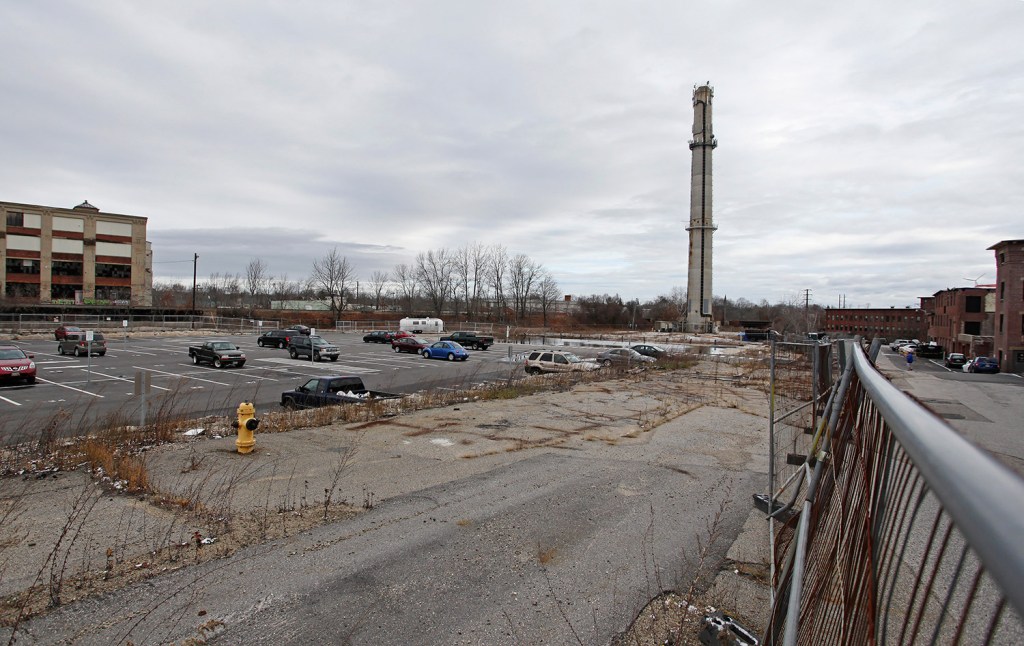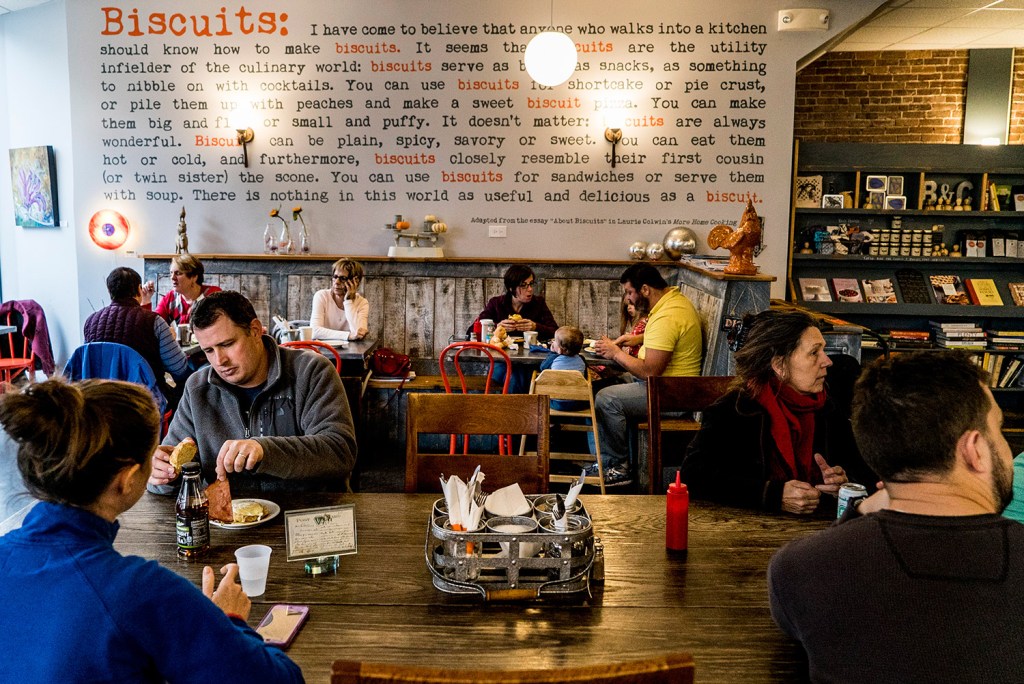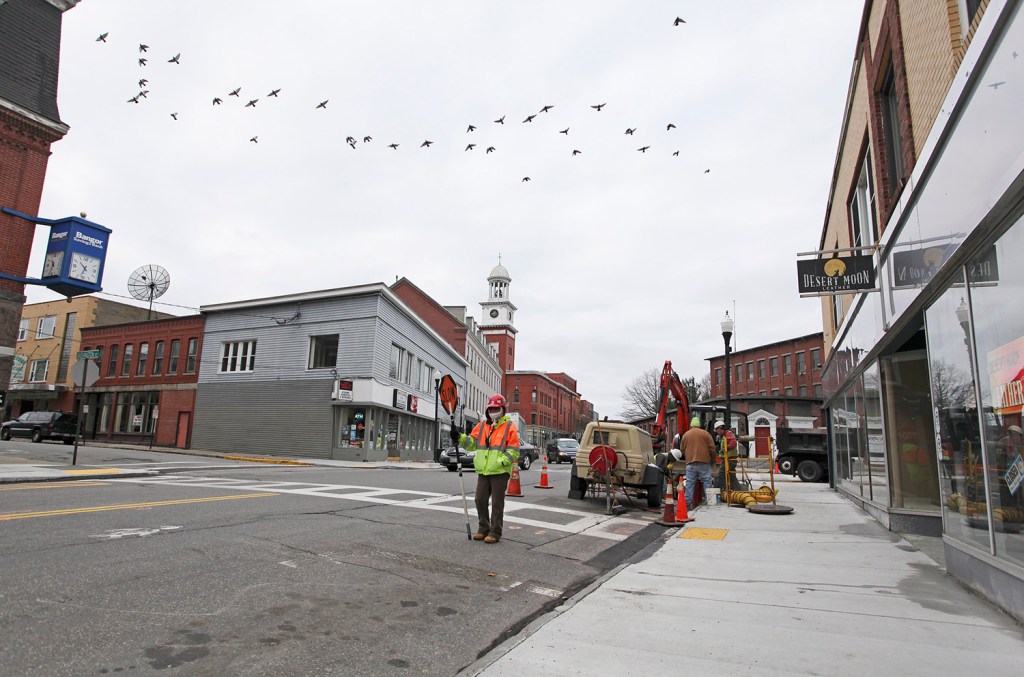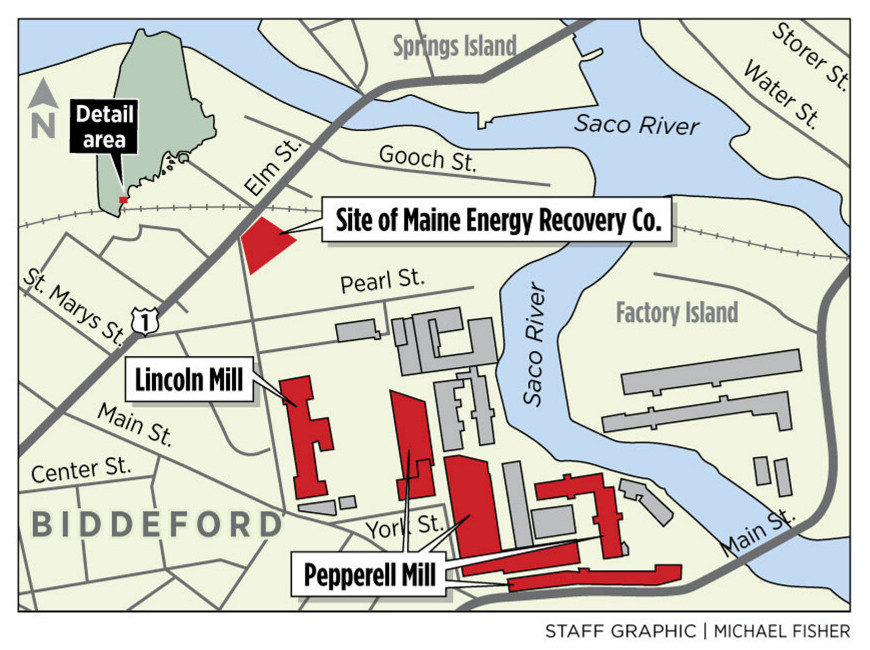It’s been four years since a trash incinerator was removed from downtown Biddeford, ushering in a new phase of redevelopment for the former mill town once dubbed “Trashtown USA.”
Sprawling brick mills are being transformed into housing, retail and industrial spaces. New shops have opened on Main Street. And a burgeoning restaurant scene is gaining regional and national attention.
But the land where the Maine Energy Recovery Co. trash incinerator once stood sits empty, save for a small section used as a parking lot.
The former Maine Energy property – an 8.5-acre riverfront parcel on Lincoln Street – is championed by city officials as a prime development spot that could further propel the city’s revitalization. They’re confident Biddeford can attract a significant development project for the site, but say the city first needs to address the lack of downtown parking that has kept some employers away. City officials say two companies recently opted not to move to the city because of parking concerns, decisions that cost Biddeford about 700 jobs.
“We’re at a crossroads. To maximize development and stabilize taxes, we have to have the parking infrastructure downtown,” Mayor Alan Casavant said. “It’s not a question of doing nothing. We absolutely have to do something in terms of parking.”
Discussions about how to provide more parking downtown and in the mill district have popped up regularly since 2012, when the City Council voted to buy the Maine Energy property for $6.65 million from parent company Casella Waste Systems. When city leaders first broached the idea of building a parking garage a short time later, some residents bristled at the idea, saying it was something private developers should pay for, not the city. Opponents even led a successful push for a referendum to ban parking meters downtown because meters had been mentioned by city officials as part of a parking management plan that would include a parking garage.
Now, the City Council is taking its first significant step forward on the parking matter by issuing a request for proposals for the location and design of a downtown parking garage. It will be up to the City Council to decide if a parking garage will be built and where it would be located.
City Councilor Marc Lessard said building a parking garage will provide opportunities for more businesses to move to Biddeford and can be paid for by revenue from the garage.
“This is a good tactic to look to for further revitalization of the downtown,” he said during a council meeting this month.
Developers who are investing in Biddeford say it is critical for the City Council to approve a parking garage so that further redevelopment isn’t stymied by the shortage of spaces.
“There’s no way all the mills can be redeveloped and filled with tenants, whether it be housing or office space or light manufacturing businesses, without more parking being available,” said developer Nathan Szanton, whose $15 million Lofts at Saco Falls opened in September adjacent to the Maine Energy property. “It would be a very savvy move for the city to build a parking structure.”
But opponents, including a member of the citizen watchdog group Concerned Citizens of Biddeford, say the city shouldn’t be on the hook for the $7 million or more it would cost to build a parking garage that may benefit a limited part of the city.
‘IMMEDIATE AND DRASTIC EFFECT’
Before Maine Energy closed, city officials and developers said the presence of a trash incinerator in the middle of the 35-acre mill district was a wet blanket on development. The city fielded complaints about trash trucks, odors and emissions from the company’s smokestacks.
Almost immediately after Maine Energy closed in December 2012, developers began buying property and announcing new projects. More than $65 million in new projects has been completed or is under way, including a $50 million housing project in the former Lincoln Mill.
Szanton announced the Lofts at Saco Falls shortly after the City Council voted to buy the Maine Energy property.
“That changed overnight with the MERC decision and we got under contract almost right away,” he said. “It had an immediate and drastic effect.”
The Lofts at Saco Falls has 80 units, 70 of which were already rented when the building opened in September. The last 10 apartments were rented within a week, primarily to people moving to Biddeford from Portland and other southern Maine towns. The Lofts at Saco Falls rents 80 parking spots on the Maine Energy property from the city and would shift those spots to a parking garage if one is built.
Developer Doug Sanford, credited with leading the way with mill redevelopment in the city over the past decade, has invested more than $5.6 million since 2012 in the Pepperell Mill Campus, creating at least 125 new jobs and absorbing more than 150,000 square feet of vacant space.
INVESTORS SEE THE POTENTIAL
Downtown commercial buildings are selling, on average, nearly 59 percent above assessed value, generating $38.3 million in new value and $716,000 in additional property tax, according to data compiled by the city. Residential properties in that area are selling for 12 percent above assessed value, adding $14.5 million in additional value and $287,000 in taxes.
“All those different businesses and entities were improbable before Maine Energy,” Casavant said. “The removal of Maine Energy completely changed the landscape, not just physically but also psychologically in making investors believe this area has potential.”
Daniel Stevenson, the city’s economic development director, said the large projects, coupled with the opening of new restaurants and shops, show that the City Council’s decision to buy the Maine Energy property is now paying off, even if the property has yet to be redeveloped. Stevenson said city officials believe the property is a desirable location for redevelopment, but initial talks with businesses and developers always include questions about parking. Businesses looking to move to Biddeford and developers interested in investing there want certainty when it comes to parking, he said.
This year, two companies decided not to move to the mill district because there was not enough parking available, City Manager Jim Bennett said, declining to name the companies because they haven’t made public announcements about their relocations. One company would have brought more than 450 jobs, while the other had about 250, he said. Both had average salaries of $50,000 and each decided to locate elsewhere in southern Maine.
“We think if there was long-term certainty and solutions, those dynamics may have been different,” Bennett said.
Tony McDonald, a broker and partner with CBRE The Boulos Company, said parking is a necessary part of an office or residential development climate, particularly in a rural state where there is limited public transportation.
“I don’t think any sane developer would make an investment without knowing parking was available,” he said. “They don’t have to necessarily own it or control it, but it has to be there so their tenants can find a place to park.”
‘THERE’S A CERTAIN BUZZ HERE’
The city’s growing interest as a destination and the demand for downtown housing also are indicators that demand for parking will continue to grow, Bennett said.
The latest Census data shows the city is now the fastest-growing community in Maine for people under 30. The median age in Biddeford is 34, significantly lower than the median ages of 42.7 for Portland and 43.5 for the state as a whole.
Bennett said many of those people are young professionals who are driven out of the Portland market by high housing prices or who want to live in an up-and-coming urban environment.
“I think there’s a certain buzz here,” Bennett said. “The community has a raw ‘it’ factor that’s attracting people to the city.”
Stacy Cooper, owner of Biscuits & Co. on Alfred Street, hears and sees that buzz regularly. She opened her restaurant two years ago after winning a business startup incentive contest co-sponsored by the city. Foot traffic and business has continued to increase since Biscuits & Co. opened, especially as other new businesses open and more people move to the area, she said. “When people get here, they discover there is a lot going on,” she said.
Casavant, the mayor, believes locals are starting to notice the changes downtown and says people now tell him they understand the need for more parking. But he recognizes there may still be resistance to the idea of the city building a parking garage instead of relying on a private developer to do it. City councilors and staff say the garage would not be funded in a way that raises property taxes, instead relying on revenue generated by the garage to pay debt service on the project.
“This is a significant vote for the city. No one will vote for a parking garage that will raise taxes,” Casavant said.
Howard Hanson, a Biddeford resident, urged the City Council during its Nov. 16 meeting to really think about how a parking garage would impact taxpayers before moving forward.
“We have a tax rate right now that’s getting into the stratosphere,” he said. “To put another burden right now onto the people who pay taxes in this city is going to be very difficult. I think we need to have a lot of clarity before you even vote on this.”
Bennett said proposals are due by Dec. 16, when the council will begin the process of looking at the best location to build a garage he estimates could cost $7.8 million to $14 million. City councilors will not make any decisions about the parking garage before January and – if they approve a garage – a construction bid wouldn’t be awarded until summer. Nevertheless, Bennett is optimistic about the path the city is on.
“All the pieces are starting to align,” he said.
Copy the Story Link
Send questions/comments to the editors.














Success. Please wait for the page to reload. If the page does not reload within 5 seconds, please refresh the page.
Enter your email and password to access comments.
Hi, to comment on stories you must . This profile is in addition to your subscription and website login.
Already have a commenting profile? .
Invalid username/password.
Please check your email to confirm and complete your registration.
Only subscribers are eligible to post comments. Please subscribe or login first for digital access. Here’s why.
Use the form below to reset your password. When you've submitted your account email, we will send an email with a reset code.